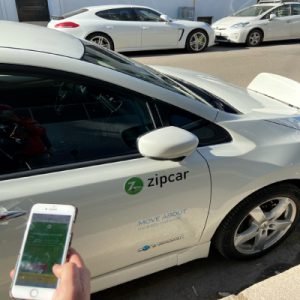
Bjørn Ove Berthelsen, Project Leader, Lighthouse City Trondheim.
With the advent of Mobility as a Service across the world, fascinating models are cropping up that implement these concepts city-wide. With parking as a focus, Sid Jalan explors one such example with Bjørn Ove Berthelsen, Project Leader, Lighthouse City Trondheim.
Trondheim is one of the largest cities in Norway, with a population of about 280,000 people. This city, along with Limerick in Ireland, forms the starting point for the Positive City Exchange project (+CityxChange). This program, which is funded by the European Union, is a smart city project that aims to help municipalities navigate the various resource complexities within their cities.
It is based around innovative interventions on mobility and energy, with an emphasis on renewables. The interventions aim to create positive energy neighbourhoods, which could even comprise of just three buildings. The idea is to ensure that these buildings consume less energy over the years, and whatever is consumed is produced locally.
We can take EV charging as an illustration of this project. Norway is possibly the largest market for electric vehicles per capita, with an EV owner exempt from paying road tax or sales tax. They also have a large network of EV charging infrastructure, powered by a large mix of renewable energy. The smart city project was based around innovative methods of integrating EV charging into the local energy neighbourhood. In order to do that, the plan is to create 2-way charging infrastructure. With this you can potentially charge your car with green energy and use the EV batteries as a source of local energy back to the buildings or to the neighbourhood. This aims to create a different distribution model for the local energy needs.
How does Parking fit into this?
 The project is future-oriented, and with the widespread adoption of EVs in Norway, the focus is through the lens of electric mobility. With shared cars increasing before the pandemic, and expected to still rise in the next decade, the intention of the project is to look at a viable and commercial model for full scale Electric Mobility as a Service (eMaaS). This scheme would integrate with all forms of public transport – Bus, Tram, Ferry, E-scooter, Airport shuttle bus, shared EVs, and even city bike schemes. With a larger emphasis on the shared EVs, Zipcar under Avis Budget Group was brought on board for the vehicles. But with self-driven shared mobility comes the concern of parking.
The project is future-oriented, and with the widespread adoption of EVs in Norway, the focus is through the lens of electric mobility. With shared cars increasing before the pandemic, and expected to still rise in the next decade, the intention of the project is to look at a viable and commercial model for full scale Electric Mobility as a Service (eMaaS). This scheme would integrate with all forms of public transport – Bus, Tram, Ferry, E-scooter, Airport shuttle bus, shared EVs, and even city bike schemes. With a larger emphasis on the shared EVs, Zipcar under Avis Budget Group was brought on board for the vehicles. But with self-driven shared mobility comes the concern of parking.
Bjørn tells us, “The biggest issues with parking is ownership, management, charging infrastructure and financial investments. So we drew up a stakeholder map to identify the requirements for this model and what players can fill those roles. You have shared EVs, providers for the charging and discharging of the system, and the main connection to the larger energy system. For the latter, the project has brought on board ABB.”
But with parking, they realised that the spaces were owned by corporate building owners or large real estate companies. That is where a parking company comes into the picture. The parking company enters into an agreement with the building owners to operate and use the parking spaces for shared EVs. These parking companies will initially be 100% owned by the municipality so that conditions can be framed appropriately.
The parking companies get funding to run the corporate spaces and also take a slice of the parking income. This is used to invest in the charging infrastructure that is required for the EVs. They also sign contracts with the car providers, like Zipcar, to allow access to the spaces. This business model considers the fact that parking companies need to take on the investments costs, and cover the CAPEX and OPEX of the charging infrastructure. Thus, this model needs to be viable for a commercial parking company as well.

The enhanced role of parking companies
The parking company becomes an integral player in the parking ecosystem, as they run the parking assets and provide first line service to the customers. The intention of the project is to also employ the parking companies in the distribution of the shared EVs. During the summer months or during bank holidays, corporate offices are either shut or not used frequently. The value of car sharing and MaaS comes from a higher utilisation of these shared vehicles. So if vehicles start to pile up in one place, these parking companies will be tasked with the redistribution of the shared EVs to locations with higher traffic like tourist or camping spots.
These companies currently track parking spots across the city, and access to this information help in the implementation of this model. They would be paid by the shared-car companies for the same and would become a part of their services-based business framework. This is intended to create a strong business case and future potential for parking companies, wherein new products will be introduced in terms of Parking as a Service.
“Encapsulating the opportunity for the parking company, they would take care of the parking space, take care of the contract with the building owner or the municipalities, they would move and distribute cars from low utilisation areas and they would offer charging infrastructure for the EVs.”
At the moment in Trondheim, most cars have fixed parking spaces. There is no big technology which is implemented for parking, but it is in the pipeline for the city. Currently various underground parking spaces exist in Trondheim which involve autonomous systems, where you drive in and your car is automatically registered through camera recognition. The city’s intention is to use public space for people, shops and leisure rather than parking. The plan is to add car sharing schemes and MaaS only when there is a significant number of shared cars. At the moment there are possibly 350 shared cars floating around the city.
The effect of the pandemic
The pandemic has delayed the implementation of the project at the moment, as the scheme was about to be rolled out just when countries went into lockdowns. For the time being, the parking infrastructure and the agreements have been setup.
The car sharing scheme will be on a B2C and B2B model, which have both been affected at by the pandemic. The market opportunities are uncertain in Norway, but the expectation is that car sharing hasn’t reached the tipping point. Most players are optimistic on the future potential, but the focus has shifted to B2C models rather than B2B. There are strong densification goals for the city, and B2C schemes are expected to grow year on year.
“When we roll out, we will start with two locations and two cars. This is not about volume because we need to build brick on brick. So we will start slow and with a lower volume in the number of cars, and gradually scale from there.”
There are also ambitious goals to reduce greenhouse gas emissions, along with strict regulations on traffic volumes in the city centre.
 TrafficInfraTech Magazine Linking People Places & Progress
TrafficInfraTech Magazine Linking People Places & Progress